35 White Flowering Weeds (with Pictures): Identification Guide
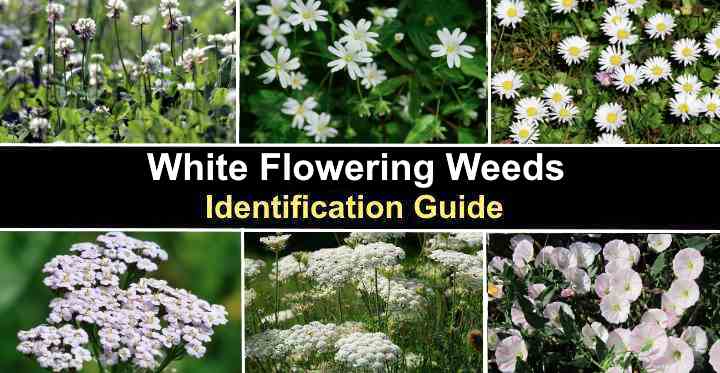
Many varieties of white flowering weeds can be invasive and detrimental to your garden’s health. Nuisance weeds with white flowers can spread by underground roots, creeping stems or produce thousands of seeds that germinate almost anywhere. The pesky plants can quickly take over an area unless you can identify and control white-flowering weeds.
Many types of weeds with white flowers have eye-catching, beautiful blooms. Despite their attractive appearance, white-flowering weeds can compete with desirable plants for nutrients, water, and sunlight. Because they tend to grow rapidly in poor soil conditions, they can spread rapidly and cause significant damage.
This article is an identification guide to the most common white-flowering weeds you are likely to find in a garden landscape. Detailed descriptions and pictures of common white weeds will help you know which plants with white flowers to weed out, and which cultivated plants to keep.
What Are White-Flowering Weeds?
A white-flowering plant is considered a weed when it’s not cultivated and grows in an unwanted area. White-flowering weeds can be native or non-native plants. They often exhibit rapid growth, resilience, and adaptability, making them difficult to control or eradicate in cultivated or natural environments.
Common white-flowering creeping lawn weeds are daisies, white clover, and chickweed. These pesky plants can spoil the appearance of a well-kept lawn. Other types of weeds with white flowers in front or backyards include stinging nettles, water hemlock, hairy bittercress, and meadow death camas.
Weeds with White Flowers (with Pictures): Identification Guide
Let’s look in detail at various types of weeds with white flowers.
White Clover (Trifolium repens)
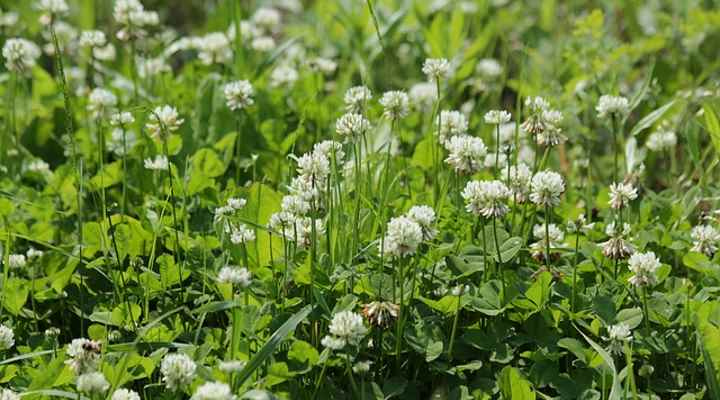
White clover is a common creeping weed with white flowers that invades lawns and gardens. The perennial weed is identified by its small creamy-white flowerheads consisting of 20 to 50 tiny petals and trifoliate leaves. The pesky lawn weed spreads through creeping stems called stolons, forming dense patches in grassy areas.
Invasive white clover blooms from spring to fall, with its white flowers growing in stems 3” to 6” (7 – 15 cm) tall. The creeping perennial can spread 18” (45 cm) wide. Due to its vigorous growth, white clover can become an aggressively spreading lawn weed.
The best way to deal with creeping white clover is by hand-pulling small clumps of the weed. However, regular mowing at the recommended height of 3” (7.5 cm) or more can prevent the plant from flowering and producing seeds. Additionally, keeping your lawn healthy by regular fertilizing can help prevent white clover from taking root.
However, white clover can be a good lawn alternative because it remains green throughout the summer, suppresses other lawn weeds, and adds nitrogen to the soil.
Common Chickweed (Stellaria media)

Chickweed is a common annual weed with small white flowers and invasive growth. This low-growing, white-flowering weed has tiny ray flowers with small white oval petals surrounding a green center. If uncontrolled, the ground-hugging weedy plant forms a dense mat that can take over lawns and gardens.
Chickweed grows around 2” (5 cm) tall, and its creeping stems spread up to 12” (30 cm) wide. The highly adaptable weedy plant grows almost anywhere, making it a difficult weed to eliminate. Chickweed spreads through seeds and creeping stolons, and can produce up to 15,000 seeds per plant.
Controlling chickweed in your yard is important because it can compete with cultivated plants and turfgrass. However, it has a shallow, fibrous root system, making hand-pulling an effective control method.
Because chickweed thrives in moist, damp soil, ensuring adequate drainage can help prevent it from taking root in lawns. Maintaining a thick, vigorous lawn can also help prevent seedlings from germinating and growing.
Hairy Bittercress (Cardamine hirsuta)
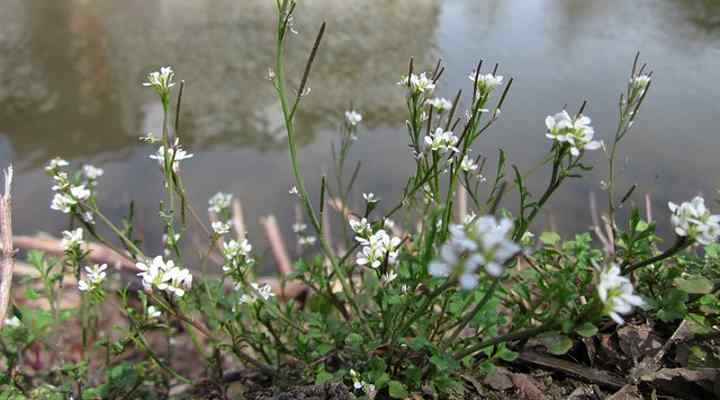
Hairy bittercress is a common annual white-flowering weed with tall, erect flower stems and a rosette of pinnately compound leaves. The small white cross-shaped flowers on this noxious garden weed grow on stems 3” to 10” (7.5 – 25 cm) tall. Its clumps of foliage consist of deeply lobed leaves up to 6” (5 cm) long.
Hairy bittercress spreads rapidly through its explosive seed pods, which can shoot seeds up to several feet away. The weed thrives in moist, shady areas, making it particularly troublesome in gardens and flower beds. Hand-pulling is often effective. However, removing the entire plant, including the root, is vital. Regular mowing and maintaining a healthy lawn can also help prevent the weed from establishing itself.
Despite being a pesky weed that spoils the appearance of lawns, it has edible foliage. Its leaves have a mild peppery taste and are not bitter despite its common name.
Daisy (Bellis perennis)

Although they have attractive flowers, daisies can become pesky weeds when growing uncontrollably in lawns and gardens. The low-growing, white-flowering weed is identified by its small, white ray flowers with yellow centers. It is a perennial weed in cool weather, but grown as an annual weed in hot summer areas. The white and yellow flowers grow close to the ground in dense clumps of spatula-shaped leaves.
Also called lawn daisies, the white daisy flowers grow up to 8” (20 cm) tall and are 1.18” (3 cm) wide.
Daisies are weeds with creeping stems and foliage that grow low and spread along the ground, making them difficult to eradicate by mowing. One way to make it harder for daisies to get established is to maintain healthy, dense grass. This makes it difficult for the vigorous weed to establish itself. However, many gardeners embrace the dainty flowers as they add a contrasting white color to lush turfgrass.
Common Mouse Ear Chickweed (Cerastium fontanum)
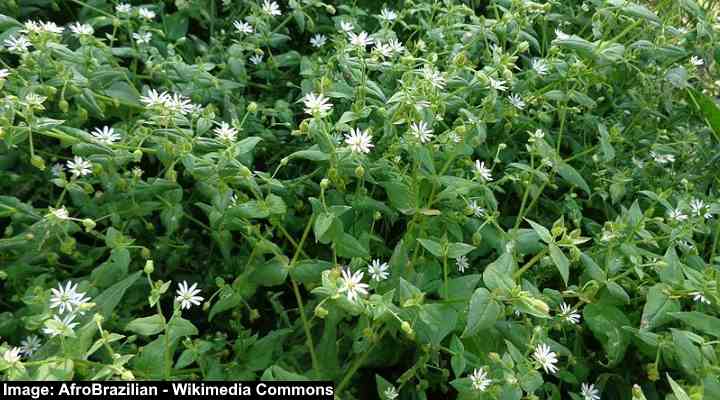
Common mouse-ear chickweed is a common white-flowering yard weed. The pesky annual weedy plant is identified by its white flowers with notched petals, small, spatula or egg-shaped fuzzy leaves, and low growth. Its dense mat-forming, rapid growth, and invasive nature make it an annoying lawn weed.
Mouse-ear chickweed competes with desirable plants and native turfgrass for nutrients, water, and sunlight. It has erect, flowering stems 18” (45 cm) tall and prostrate leafy stems that spread through flower beds and lawns, smothering vegetation as it goes.
Controlling mouse-ear chickweed can be challenging because it spreads rapidly by both seed and runners. Like eradicating most lawn weeds, maintaining a healthy lawn can help prevent the weed from becoming invasive. Also, you can hand-pull clumps of the weeds from flower beds.
Wild Carrot (Daucus carota)
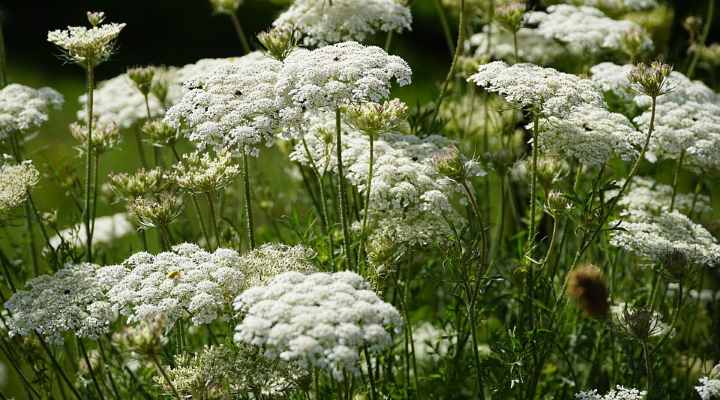
Also called Queen Anne’s lace, wild carrot is a common biennial weed with large flat-topped clusters of white flowers. The upward-facing umbrella-like clusters (umbels) of lacey flowers grow at the ends of hairy stems 1 to 4 ft. (0.3 – 1.2 m) tall. Its bristly green triangular feathery fern-like leaves grow as a basal rosette.
Wild carrots can be a nuisance in gardens and cultivated areas; however, the weed has some beneficial qualities. The nectar-rich white flowers attract bees and butterflies when blooming from May through September. Although its young leaves and roots are edible, the pesky plant resembles poison hemlock.
Controlling wild carrot can be challenging due to its deep taproot, which is difficult to remove by hand. Regular mowing or cutting the flower heads before they go to seed can help prevent the spread of the weed. Additionally, mulching or using a weed barrier can help suppress the growth of wild carrot in garden beds.
Horseweed (Erigeron canadensis)
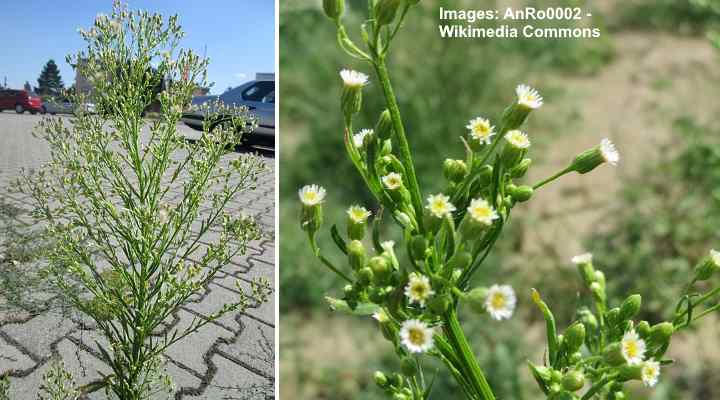
Horseweed is a bushy white-flowering weed that can be a nuisance in gardens, lawns, and pastures. This invasive weed is characterized by its tall, slender stems with clusters of urn-shaped white daisy-like flowers. The slender lanceolate leaves measure 3” to 4” (7.5 – 10 cm) long, growing on tall stems up to 5 ft. (1.5 m) tall.
Removing the weeds by hand is the best way to get rid of horseweed from gardens and lawns. Despite its shallow taproot, it develops spreading fibrous stems underground that easily break when hand-pulling. Unfortunately, trimming, cutting, or mowing the shoots at the base only encourages more vigorous growth.
Pearlwort (Sagina procumbens)
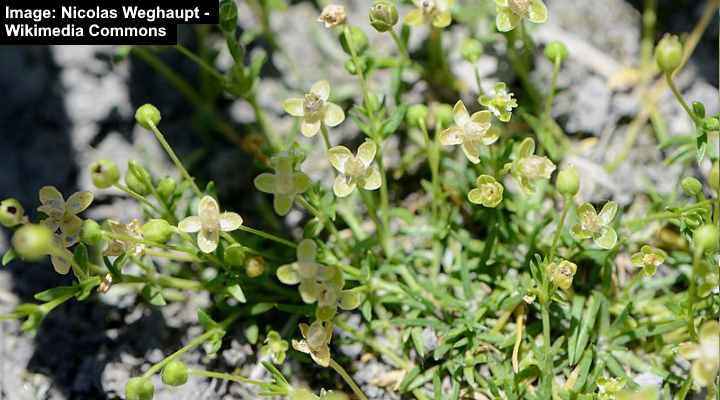
Pearlwort is a low-growing, spreading weed-like plant forming dense mats of green foliage and small, white-greenish flowers. Thriving in moist, damp conditions, the white-flowering annual or short-lived perennial weed spreads quickly, forming clumping mounds 2” (5 cm) tall. The weed is characterized by its small, round leaves 0.4” to 0.8” (1 to 2 cm) long and tiny five-petalled white and pale green flowers.
Controlling pearlwort can be challenging because its seeds spread easily by mowing or foot traffic. However, improving drainage to reduce soil dampness can hinder its growth and spread. If pearlwort has taken root in a lawn, improving grass health by fertilizing, aerating, and overseeding can outcompete the weed.
Stinking Chamomile (Anthemis cotula)
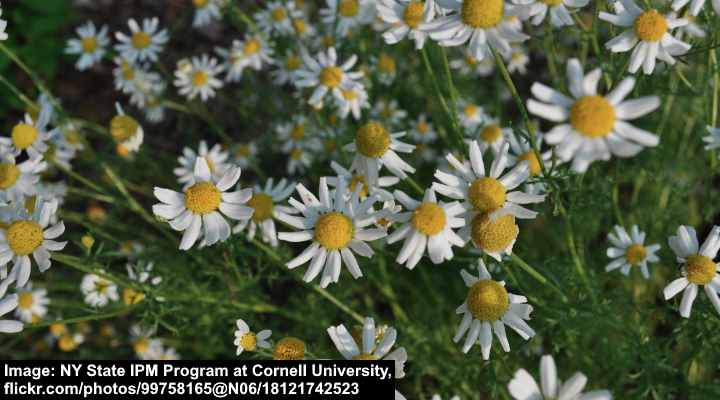
Stinking chamomile is a common annual weed with daisy-like flowers. The identifying features of this odorous, tall, white-flowering weed are its ray flowers with white petals surrounding a yellow center, and fuzzy leaves that are 2 inches (5 cm) long, growing on stems that are 2 feet (0.6 m) tall.
As its name suggests, the stinking chamomile is a nuisance weed that emits a foul, pungent odor when its leaves or flowers are crushed. Its growth habit and flowers also resemble those of the true chamomile plant, Anthemis nobilis. Also called mayweed, this stinking plant chokes out desirable ornamentals in yards.
Apart from its invasive, aggressive growth, stinking chamomile contains irritating chemicals that cause eye irritation and skin rashes. Therefore, you should wear protective gear when removing the noxious weed by hand.
White Yarrow (Achillea millefolium)
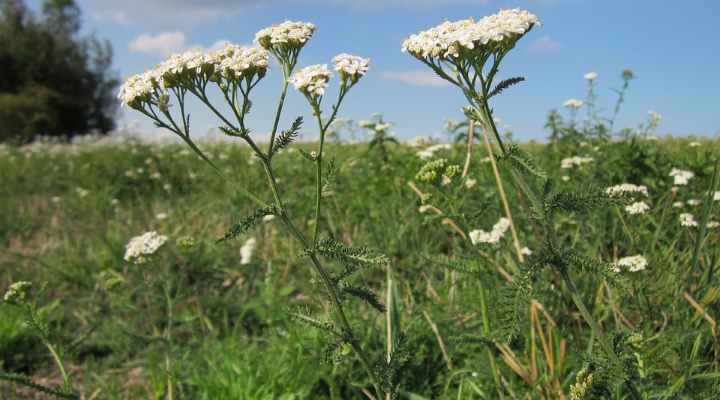
White yarrow is a tall perennial weed with white flowers that self-seeds and can become invasive if allowed to grow unchecked. The eye-catching features of this weedy plant are its feathery, fern-like leaves and clusters of small, white flowers that bloom throughout the summer and fall. White yarrow spreads quickly through its thin, fibrous roots and invades lawns.
White yarrow is a hardy weed that thrives in dry soils. Although the spreading plant is useful as white-flowering ground cover, mixed borders, or coastal gardens, it becomes a nuisance in lawns. The weedy plant, with its airy clusters of white flowers, grows 2 to 3 ft. (0.6 – 1 m) tall and up to 2 ft. (0.6 m) wide.
Black Nightshade (Solanum nigrum)
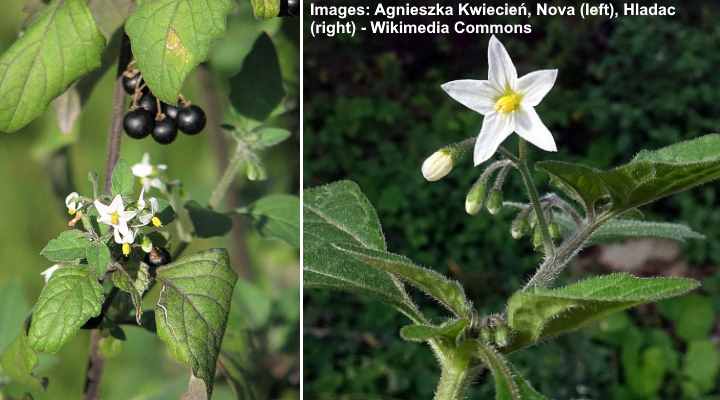
Black nightshade is a white-flowering bushy weed with small clusters of white star-shaped flowers. The summer weed is characterized by its small white flowers growing in clusters of four to eight, dark-green pointed leaves with a purple tinge, and blackish-purple berries. This annual or short-lived perennial weed invades yards, gardens, and disturbed sites.
Black nightshade can grow up to 2 to 4 ft. (0.6 – 1.2 m) tall and spread up to 3 ft. (1 m) wide. Its weedy tendencies mean it competes with native plants for essential nutrients.
Black nightshade is also a highly toxic weed that can cause severe gastrointestinal upset when ingesting raw parts of the plant. Although the berries are edible, they are easily confused with the highly toxic, deadly nightshade Atropa belladonna.
Stinging Nettle (Urtica dioica)
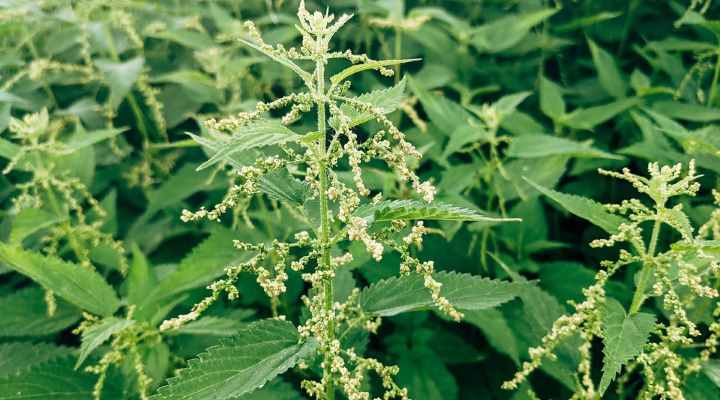
Native to North America, stinging nettle is a tall perennial weed with spikes of greenish-white flowers. Also known as burn-weed due to its stinging leaves, the nettle is identified by its elongated, lance-shaped leaves with serrated margins and short flower clusters emerging from its branches. This rapidly spreading plant forms large, weedy clumps.
Stinging nettles grow 3 to 7 ft. (1 – 2 m) tall. The tall, spreading weeds are characterized by their bristly hairs that puncture the skin, causing irritation, skin rashes, and blisters. These symptoms may last for 12 hours.
Hand-pulling is the best way to remove the stinging weeds from gardens. Removing all rhizomes from the ground is vital to ensure complete eradication. Mulching can help to smother and inhibit stinging nettle growth.
Common Hemp-Nettle (Galeopsis tetrahit)
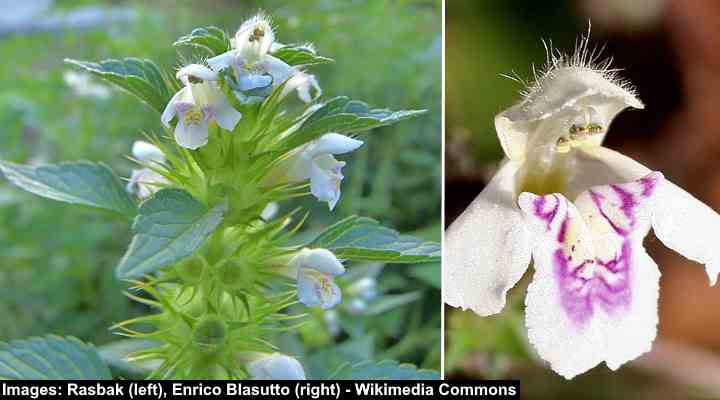
Common hemp nettle is a flowering weed with clusters of small white, purple, and pink flowers. This annual herbaceous weed is characterized by its square stems, lance-shaped leaves, and small whitish flowers. The tall, weedy plant can grow up to 3 ft. (1 m) and has a strong taproot.
Common hemp nettle is considered an annoying weed for several reasons. First, it spreads rapidly through its seeds. Second, it competes with native plants for essential soil nutrients. Third, it’s an adaptable plant that thrives in various conditions, including poor soil and shade. Additionally, hemp nettle can outcompete native plants, leading to a decrease in biodiversity.
Japanese Knotweed (Reynoutria japonica)
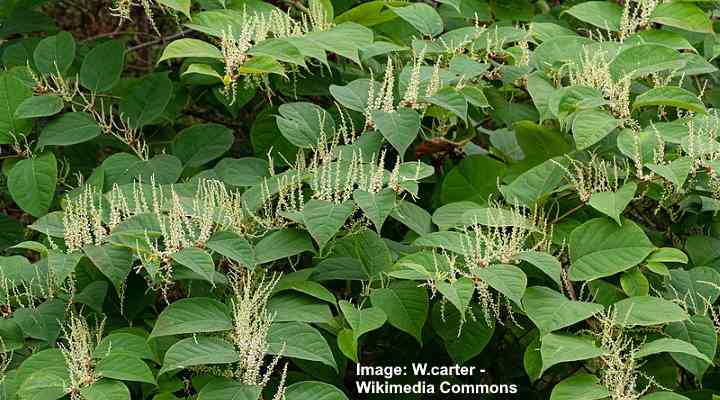
Japanese knotweed is a highly invasive weed identified by its long flowering spikes covered in creamy-white flowers. Other identifying features of this non-native weed include its large heart-shaped leaves growing on tall stems up to 10 ft. (3 m) tall and thick, spreading roots 15” (40 cm) in diameter.
Uncontrolled Japanese knotweed can cause significant damage to garden landscapes. This perennial plant overtakes native vegetation with its bamboo-like stems, heart-shaped leaves, and clusters of small white flowers.
Controlling Japanese knotweed is challenging due to its resilient root system. Typically, the only way to completely eradicate the noxious weed is to dig up the entire root system. Because it’s labor-intensive to get rid of the weed, preventing it is crucial in managing its spread.
Field Bindweed (Convolvulus arvensis)
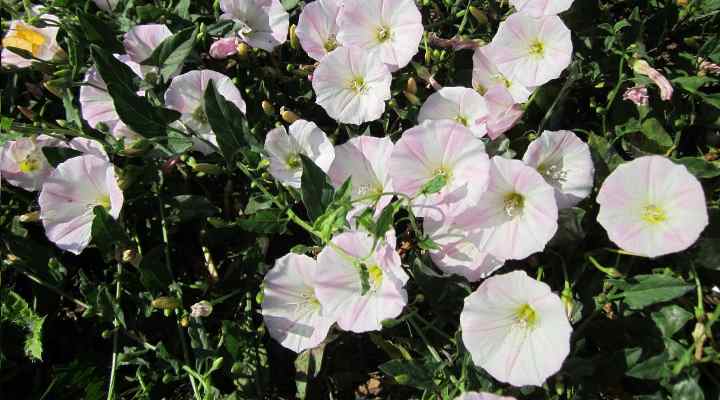
Bindweed is a white and pink flowering, low-growing spreading plant with weedy tendencies. The weed is characterized by its twining vine-like stems, heart-shaped leaves, and trumpet-shaped white flowers with pale pink markings. Field bindweed is invasive due to its vigorously spreading stems and roots up to 14 ft. (4 m) deep.
Bindweed spreads rapidly and quickly overtakes other plants in garden landscapes. Its spreading stems grow between and up through the foliage of other plants. In time, the weed chokes out desirable plants. It can also take root in turfgrass; killing it with herbicides is often the only option.
To control bindweed in flower beds, try pulling or digging up the weed as much as possible. Also, mulching the affected area with fabric and bark can help kill the pesky weed. However, it can take three years of persistent effort to eradicate the annoying weed.
Thale Cress (Arabidopsis thaliana)
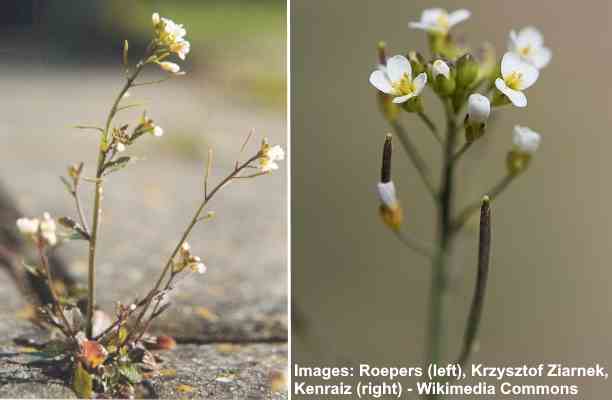
Thale cress is a small flowering weed identified by its small white flowers growing in small clusters. This small annual or biennial weedy herb grows 2” to 12” (5 – 30 cm) tall. The pesky plant produces small, ground-hugging rosettes of elongated, oval leaves before producing erect flowering stems with terminal clusters of white flowers.
Thale cress is also highly adaptable to different growing conditions, making it a weedy plant in many landscapes. This easily spreading weed doesn’t usually become problematic in garden landscapes.
Shepherd’s Purse (Capsella bursa-pastoris)
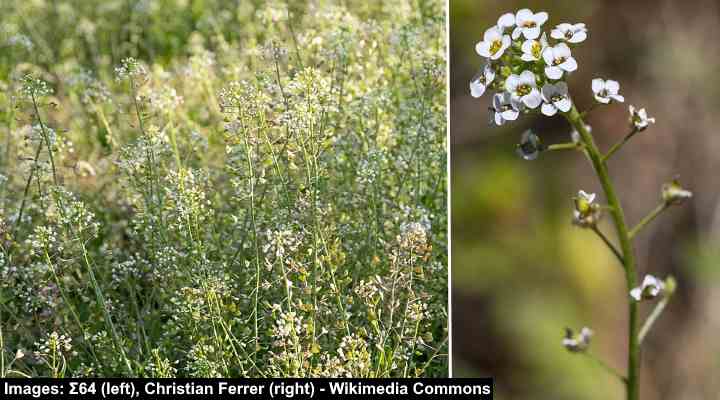
Shepherd’s purse is a common white-flowering weed with rounded clusters of small white flowers and heart-shaped seed pods. This winter annual blooms from spring to mid-summer and spreads easily in cultivated soil. The weed’s invasive habit comes from the thousands of seeds it produces. Shepherd’s purse grows 7” to 20” (17 – 50 cm) tall.
Shepherd’s purse thrives in full sunlight to partial shade. This annual weed is identified by its purse-like seed pods, and the plant can produce up to 50,000 seeds annually. Additionally, the seeds can remain viable in the soil for several years, making it difficult to eradicate the weed once it becomes established.
Getting rid of shepherd’s purse weeds involves typical control methods—hand-pulling, regular mowing, mulching, and maintaining a healthy lawn. Like controlling most seed-spreading weeds, removing the weed before it flowers and sets seed is crucial.
Jimson Weed (Datura stramonium)
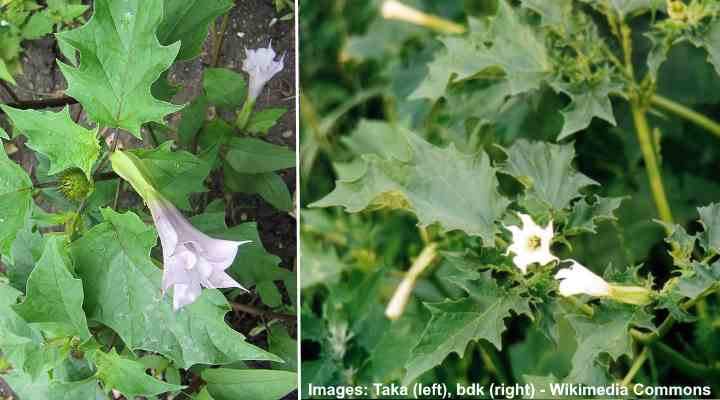
Jimson weed is a pesky annual plant with invasive growth that produces spectacular white trumpet-shaped flowers. The poisonous plant grows in unwanted places and can be found in gardens, fields, and waste areas. This invasive plant is characterized by its large, white to pale purple funnel flowers and spiny seed pods. It grows 2 to 5 ft. (0.6 – 1.5 m) tall.
Jimson weed is highly toxic and can cause serious health problems if ingested or touched.
Controlling Jimson weed can be challenging due to its deep taproot and ability to produce many seeds. Removing the flowers and seed pods before they mature is vital for preventing the weed from spreading. Maintaining a healthy lawn and garden can also help prevent the weed from establishing itself.
If you encounter Jimson weed in your yard, it’s recommended to wear gloves and protective clothing when handling the plant.
Water Hemlock (Cicuta)
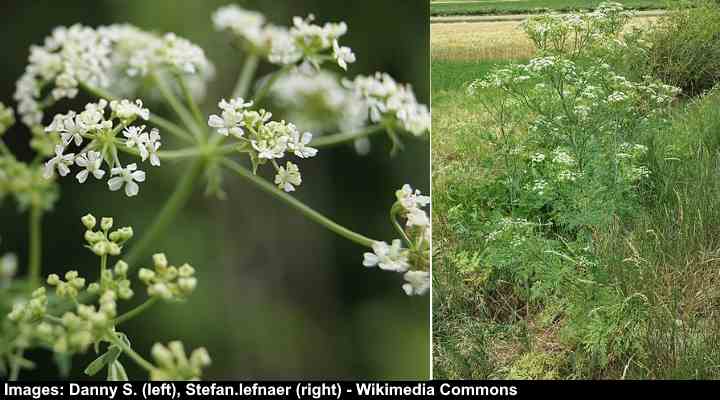
Water hemlock is a highly toxic white-flowering weed with small white flowers growing in umbrella-like clusters (umbels). Identifying features of the poisonous weed are its fern-like leaves and white flower clusters growing on erect branches. The noxious weed grows 8 ft. (2.4 m) tall.
White-flowering weed identification is vital because water hemlock is one of the most poisonous plants in North America and poses a serious threat to humans and animals. The weed resembles other flowering weeds like wild carrot and Queen Anne’s lace. Due to its toxicity, it is vital to take extreme caution when removing water hemlock.
It is best to avoid contact with the plant and wear protective clothing, including gloves and eye protection. If you suspect water hemlock is growing in your area, contacting a professional for safe removal is recommended.
Daisy Fleabane (Erigeron annuus)
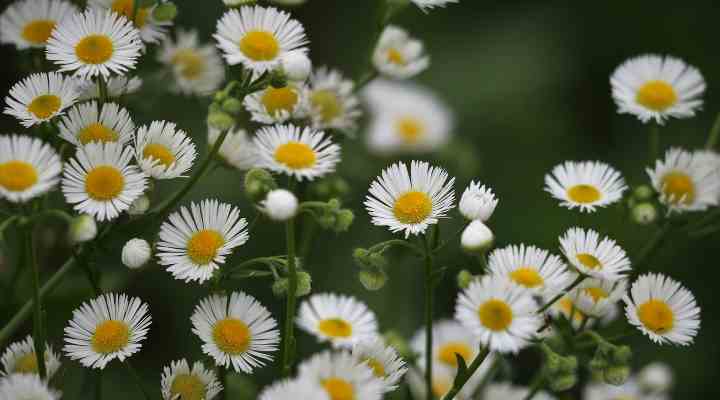
Fleabane is a type of daisy with ray flowers on nodding stems that resemble white daisies or chamomile flowers. Also called Annual Fleabane, this annoying, weed-like plant bears white flowers with a yellow center. Its blue-green, spoon-shaped, fuzzy leaves grow on bristly-hairy stems emerging from a basal rosette.
Daisy fleabane can grow 1 to 5 ft. (0.3 – 1.5 m) tall and spreads easily through wind-dispersed seeds. It can become an annoying lawn weed, and its robust taproot makes eradication difficult. However, the native wildflower can look attractive in flower beds. Its brightly-colored white and yellow flowers add a pop of color and attract pollinators.
Because of its rapid growth and spreading nature, daisy fleabane can be useful for covering bare ground. It is also relatively easy to control fleabane by hand-pulling or cutting the weed before its flowers go to seed.
White Wood Violet (Viola sororia albiflora)
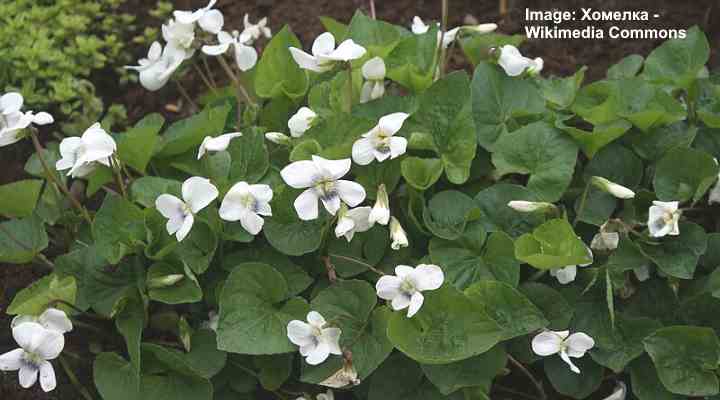
White wood violet is a native wildflower with four-petaled white flowers, delicate purple veins, and heart-shaped leaves. This low-growing flowering plant is often cultivated as ground cover for its attractive white flowers. However, it spreads quickly and grows in places you don’t expect—a reason why some people classify it as a weed.
White wood violet typically grows 4” (10 cm) tall and 6” (15 cm) wide. It thrives in the light shade, making it a good option as an understory plant to add color and foliage to bare ground. The white-flowering plant spreads through horizontally branched rhizomes. Regular weeding easily controls the spreading wildflower if it gets out of hand.
Smooth White Violet (Viola macloskeyi)
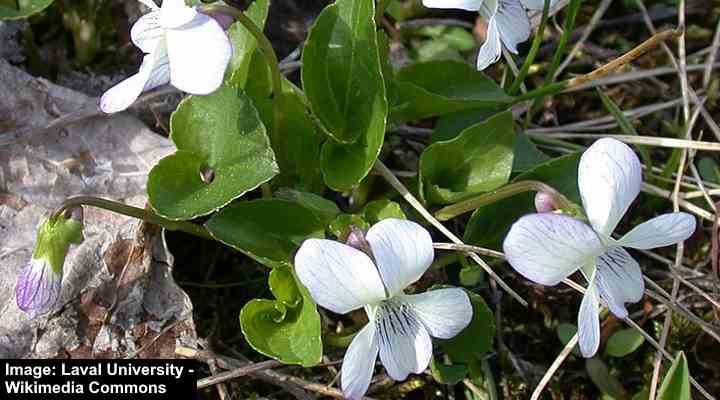
Smooth white violet is a white-flowering creeping plant that forms dense patches of foliage and pretty white flowers. The white violets are sometimes called weedy when they grow in unwanted places. However, the plant’s rapid growth and tolerance for damp, marshy ground in the shade give it some useful properties as a white-flowering ground-cover plant for shade.
Also called Macloskey’s violet, the weedy plant grows 4” (10 cm) tall and spreads through stolons that easily root in the soil. Thankfully, removing the spreading plant from lawns is easy by hand-pulling the roots. However, it rarely becomes invasive in yards in North America.
Meadow Death Camas (Toxicoscordion venenosum)

Meadow death camas is a poisonous perennial weed plant identified by its creamy-white flower clusters growing on tall stalks. The white-flowering toxic plant has 3 to 12 long V-shaped grassy leaves. The strap-like foliage grows up to 27” (70 cm) tall. The white flowers on the conical flowerhead have pale yellow stamens, making the weed easily identifiable.
Meadow death camas is included in the list of white-flowering weeds due to its toxicity. All parts of this poisonous weed are toxic and can induce nausea, vomiting, and dizziness if consumed. It is claimed that this plant has caused more fatalities than any other plant in North America.
Identifying poisonous weeds is vital to avoid coming into contact with its toxic leaves. Meadow death camas look like wild onion, but its bulb lacks the distinctive onion scent. Removing the entire plant, including the bulbs, from affected areas by hand-pulling or digging is important.
Giant Hogweed (Heracleum mantegazzianum)
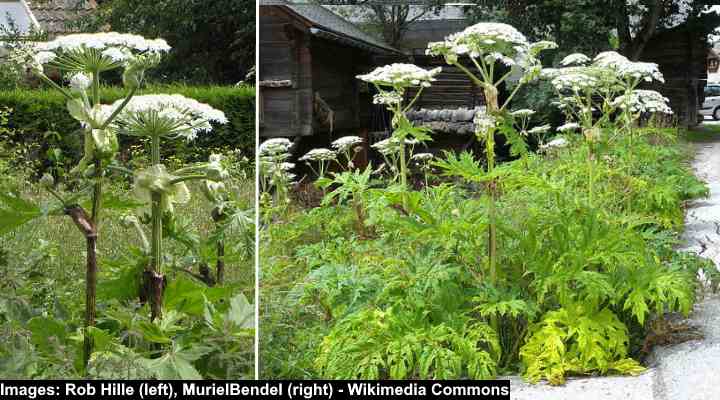
Giant hogweed is a highly invasive weed easily recognizable by its huge umbrella-shaped clusters of greenish-white flowers. The identifying features of giant hogweed are its robust hollow green stems with purple or red patches, flat-topped flower clusters up to 3 ft. (1 m) wide, and enormous green, deeply lobed leaves 3 to 5 ft. (1 – 1.5 m) wide.
Giant hogweed is a dangerous weed and a significant problem in many areas. The huge noxious weed grows 6 to 16 ft. (1.8 – 5 m) tall. Its ridged stems contain toxic sap that can cause severe burns and blisters when it comes into contact with the skin.
Giant hogweed spreads rapidly and outcompetes native plants, reducing biodiversity and disrupting ecosystems. It’s also easy to mistake young giant hogweed for cow parsnip.
It’s vital to use protective clothing and eye protection when removing giant hogweed from properties. However, it’s usually best to get professional assistance to remove the plant safely and prevent regrowth.
Garlic Mustard (Alliaria petiolata)
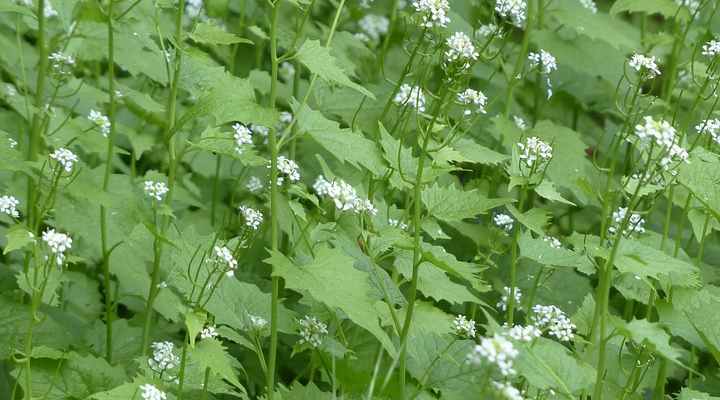
Garlic mustard is an invasive weed with erect, slender stems and small clusters of white star-shaped flowers. The weedy plant has rosettes of green triangular leaves, small white four-petalled flowers 0.12” (3 mm) wide, and a distinctive garlic aroma when crushing the leaves. The tall stems grow in clumps up to 3 ft. (1 m) tall.
Garlic mustard weeds spread rapidly, quickly taking over natural areas and gardens. The biennial weed thrives in the shade and infests woodlands, choking out native plants and reducing biodiversity. Hand-pulling is an effective weed control method for small infestations in front or backyards. It is also important to destroy the pulled weeds to prevent further spread.
Greater Stitchwort (Rabelera holostea)
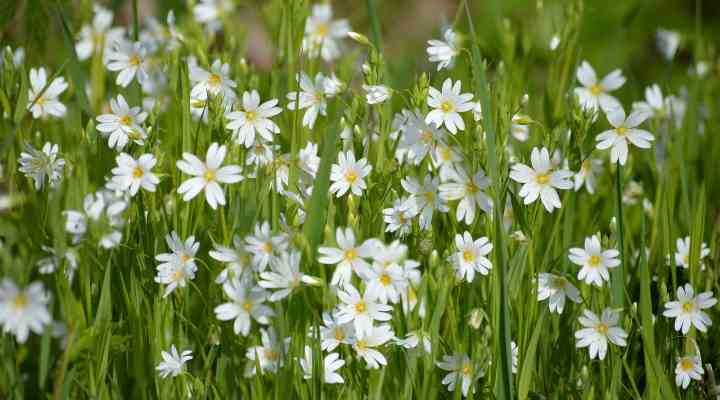
Greater stitchwort is a fast-spreading perennial wildflower with beautiful white starry flowers and weedy growth. The identifying features of the white-flowering plants are its five white petals, each with a deep notch and grass-like leaves. Its attractive white flowers measure 0.78” to 1.12” (2 – 3 cm) in diameter.
Greater stitchwort typically grows in woodlands, hedgerows, and grassy areas and blooms in spring and early summer. Although its white flowers look attractive in hedgerows, its creeping nature means it grows easily where you don’t want it. Apart from its spreading stems, it shoots seeds several feet away, adding to its invasive nature.
However, it’s a beneficial pollinator plant as it attracts bees, butterflies, and other insects. It also provides habitat and food for wildlife, making it an important plant for biodiversity.
Ground Elder (Aegopodium podagraria)
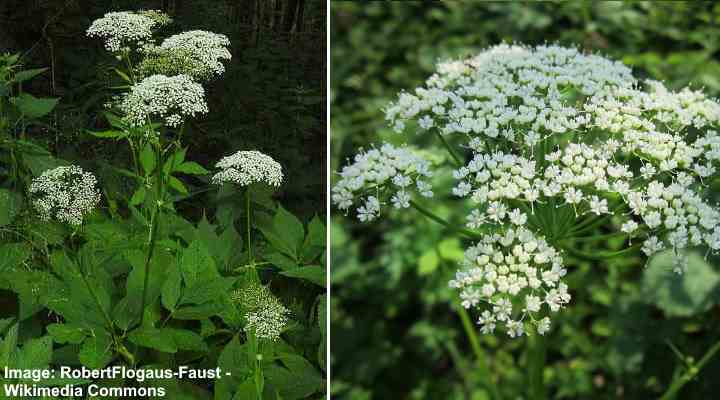
Ground Elder is a persistent weed identified by its large clusters of white flowers growing in umbrella-shaped flowerheads. The white umbels grow at the end of erect, hollow stems with grooved sides. The weed’s leaves are lanceolate with serrated margins and prominent veins.
Ground elder grows up to 3 ft. (1 m) tall and can quickly take over gardens and lawns if uncontrolled. This invasive perennial weed spreads through its robust underground rhizomes and seed dispersal. Its aggressive growth makes it difficult to eradicate. Also, the pesky, hard-to-control plant competes with ornamental plants and forms dense patches, shading out other vegetation.
Ground elder is difficult to remove, as the rhizomes can regrow from the small pieces left in the ground. Because of its highly invasive nature, the sale of the weedy plant is banned in several states in the US.
Cow Parsley (Anthriscus sylvestris)
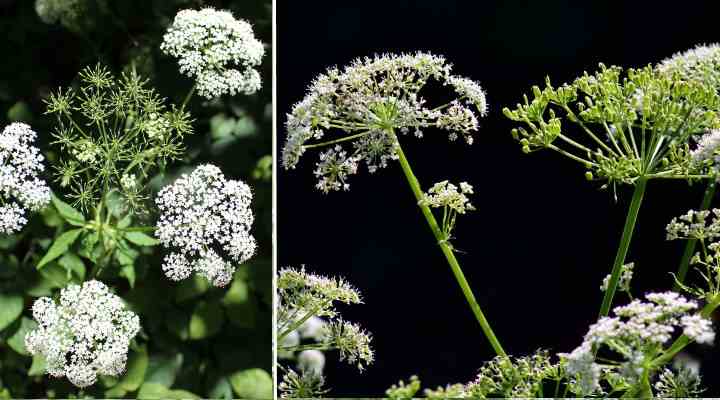
Cow parsley is a tall perennial weed with small, airy clusters of delicate white flowers. The identifying features of the fast-growing, spreading weed are its fuzzy leaf stalks, triangular, lobed leaves, and small white flowers, each with five petals. The flowers form large, umbrella-shaped clusters and bloom from late spring to early summer.
Cow parsley is a tall weed, growing 2 to 5.5 ft. (0.6 – 1.7 m) in height. It spreads easily through its abundant seeds and underground roots. Although this edible plant has several beneficial uses in gardens, its fast, uncontrollable growth makes it a nuisance, particularly in moist, shady areas.
Feverfew (Tanacetum parthenium)
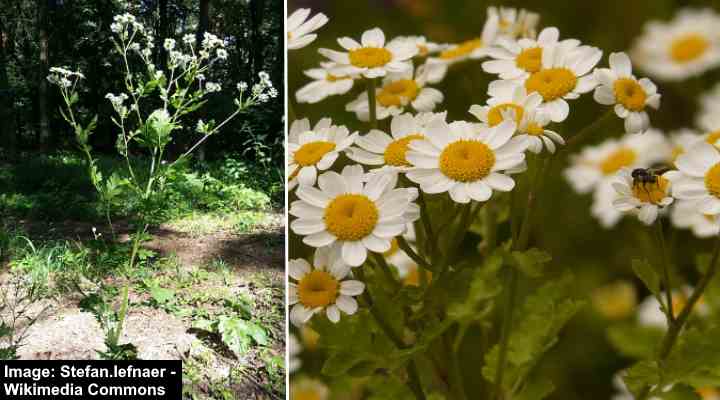
Feverfew is a tall, white-flowering herbaceous bushy plant with white and yellow daisy-like flowers. The perennial plant becomes weedy if not properly controlled. It grows in small clumping mounds up to 2 ft. (0.6 m) tall. Identifying features of the plant are its small white flowers with yellow centers and deeply lobed leaves.
Feverfew is considered a nuisance weed because it aggressively self-seeds. It can quickly take over flower beds and crowd out desired plants in optimum conditions. Additionally, feverfew has a strong, bitter odor that some people find unpleasant. It also goes by the common names mid-summer daisy, pale maids, wild chamomile, and bachelor’s buttons.
If you decide to grow feverfew, it’s important to ensure its growth doesn’t get out of control. Hand-pulling the entire plant or removing the flowers before they go to seed can help prevent its unwanted spread.
Wood Sorrel (Oxalis montana)
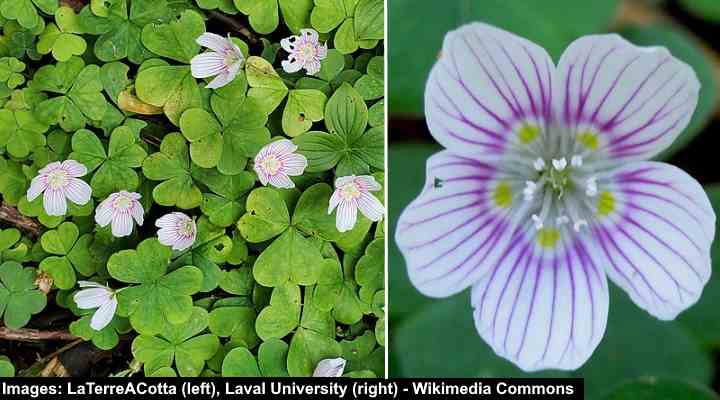
Wood sorrel is a weedy plant with delicate cup-shaped white flowers and trifoliate clover-like leaves. The low-growing, sometimes invasive plant is characterized by its groups of three heart-shaped leaves, white flowers with pale purple bands, and clumping nature. The small perennial plant grows 4” (10 cm) tall and spreads indefinitely.
Wood sorrel is difficult to eradicate because it spreads through its stolons and extensive root network. This growth habit causes wood sorrel to invade lawns and take over flower beds. The best control method is to hand-pull the weeds. However, the roots of the spreading weed easily break apart and regrow.
Mulching and improving lawn health can help prevent the weeds from taking over turfgrass. Although it’s a good plant for borders and ground cover, it can become a persistent weed with invasive growth that requires consistent control and weeding.
Marestail (Conyza canadensis)
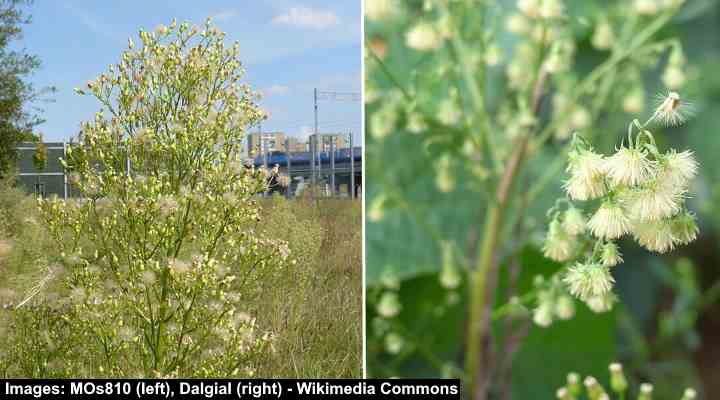
Also called horseweed, marestail is an annual white-flowering weed with greenish-white flowers and an invasive nature. The young plant grows as a basal rosette of slender, lanceolate leaves. However, it quickly grows tall, erect stems covered in willow-like leaves and can reach a height of 3 to 6 ft. (1 – 1.8 m).
Marestail has white flowers that are urn-shaped, resembling tiny thistles, with a small crown of white petals surrounding a yellow center. The tall, weedy plant blooms in July and disperses hundreds of thousands of seeds from August through October. These pesky seeds can remain dormant for up to 20 years.
The best way to eradicate marestail is by hand-pulling the tall weeds. Other ways to limit the impact of marestail in vegetable patches are to till the ground in the spring and practice crop rotation. Also, shade hinders its growth. Therefore, mulching or ground covers can help prevent the seeds from germinating.
Wild Madder (Rubia peregrina)
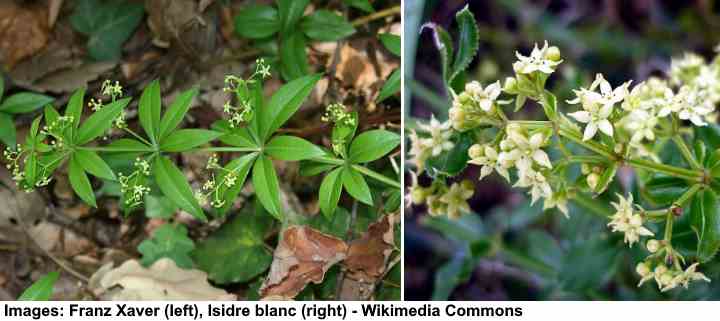
Wild madder is a tough perennial weed with small five-petalled star-shaped white or pale green flowers. The nuisance weed is characterized by its small white flowers, long, trailing stems, and strong root system. The low-growing weed’s evergreen foliage spreads on stems up to 8 ft. (2.5 m) long.
Wild madder flowers from April to June and spreads through seeds and underground rhizomes, making it a challenging weed to control. The hardy weed thrives in dry and rocky soil and grows among bushes, thickets, and pathways. It is mainly found in Britain and North Africa.
Common Boneset (Eupatorium perfoliatum)
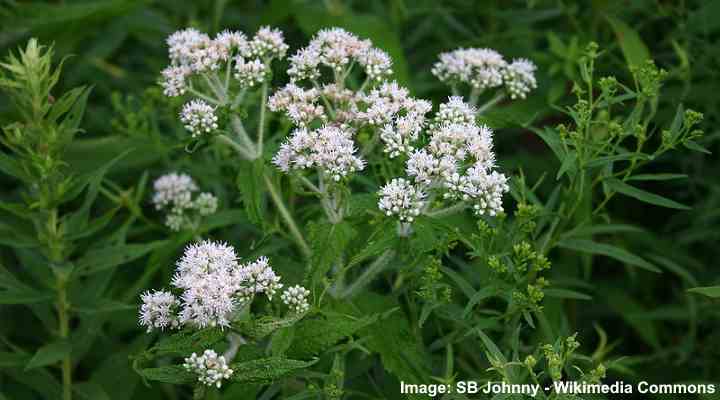
Common boneset is a flowering weed with flat-topped clusters of white flowers. The clusters of white fuzzy umbels grow at the top of 2 to 4 ft. (0.6 – 1.2 m) stems. The stems are covered in long white hairs and have lance-shaped leaves 8” (20 cm) long. The white-flowering weed blooms in late summer through fall.
Also called agueweed or feverwort, the weedy plant can be found in wet areas, such as marshes and along riverbanks. Despite being classified as a weed, common boneset is often used in wildflower and cottage gardens to attract beneficial insects like bees and butterflies. Additionally, its clump-forming habit and tolerance to wet soils mean it thrives in areas where other white-flowering plants struggle.
Valerian (Valeriana officinalis)
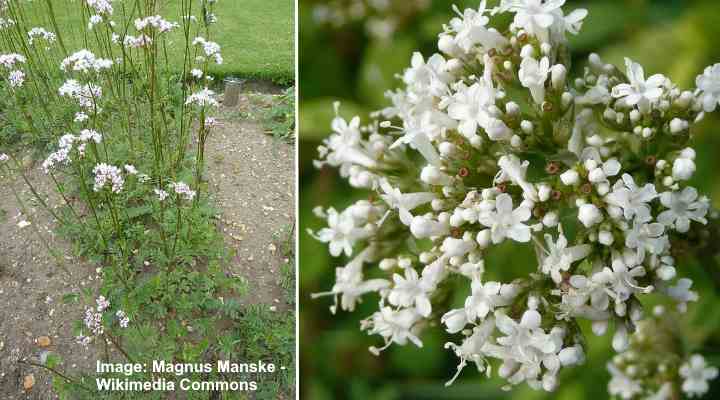
Valerian is a noxious perennial weed with pale pink or white flowers. This weedy plant is characterized by its tall, slender stems, clusters of small white or pale pink flowers, and fern-like leaves. Valerian grows 1.5 to 4 ft. (0.5 – 1.5 m) tall and spreads quickly if not controlled.
Valerian is a vigorous plant and a prolific self-seeder. It thrives in various growing conditions and tolerates dry and wet soil. It also has a network of spreading rhizomes that allow it to spread aggressively. Valerian can also take over gardens and open areas, shading out other plants and competing for nutrients.
Hand-pulling is the most efficient control method for removing a few valerian plants. Mowing can also be effective if you cut the plant down before it sets seed. However, you must remove the entire root system to prevent it from returning.
Related articles:
